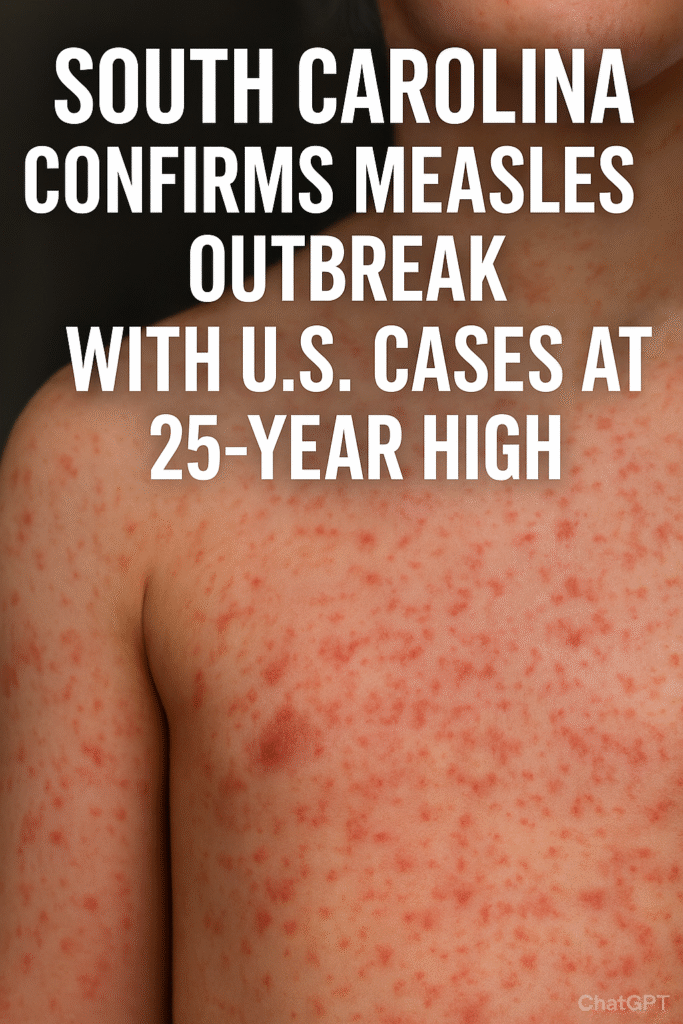
COLUMBIA, S.C. — Health officials in South Carolina have confirmed an outbreak of measles in the Upstate region, adding to a nationwide surge that has pushed the number of infections in the United States to its highest level in a quarter of a century. This alarming situation has led to what is being referred to as the South Carolina measles outbreak.
According to the South Carolina Department of Public Health (DPH), eight confirmed cases have been detected in the region, all involving individuals who were unvaccinated and lacked immunity from previous infection. The agency is actively notifying residents who may have been exposed and urging anyone with symptoms to stay home and seek medical advice before visiting clinics or emergency rooms.
America Faces Its Largest Measles Resurgence in Decades
The outbreak in South Carolina comes during what health experts are calling the worst year for measles since the disease was officially declared eliminated in the United States in 2000. This is significant as the South Carolina measles outbreak is part of a larger trend. As of early October, more than 1,500 cases have been reported across 41 states, according to data from the U.S. Centers for Disease Control and Prevention (CDC).
Nearly 92 percent of those infected were either unvaccinated or had unknown vaccination status, reflecting a troubling national trend of declining immunization rates.
The CDC has warned that measles remains one of the most contagious viruses known to humans — capable of lingering in the air for up to two hours after an infected person leaves a room. Before the introduction of the measles vaccine in 1963, the disease hospitalized an estimated 48,000 Americans annually and claimed 400 to 500 lives every year.
South Carolina Officials Brace for More Cases
Dr. Linda Bell, South Carolina’s state epidemiologist, said the department expects the number of infections to rise.
“We anticipate more cases will be identified and implore community members to act responsibly,” she said in a public statement. “If you are ill, stay home.”
While officials have not disclosed specific locations or ages of those infected, the cases are believed to be connected through close contact in community settings. The DPH emphasized that a measles outbreak is defined as three or more connected cases, suggesting the virus is now spreading locally.
Health authorities are conducting extensive contact tracing, vaccination outreach, and public education campaigns to contain the spread.
Texas Outbreak and the Broader National Context
Earlier this year, Texas experienced one of the country’s largest outbreaks, with two children dying from complications related to measles. Although Texas officials declared that outbreak over in August, cases have continued to rise elsewhere, including in the Southeast and parts of the Midwest.
Nationwide, health experts have linked the resurgence to falling vaccination rates, travel-related exposures, and a growing wave of vaccine misinformation that has eroded public trust in long-established immunization programs.
Public health professionals warn that measles could regain a permanent foothold in the country if vaccination rates continue to decline.
What Makes Measles So Dangerous
Measles is an airborne viral illness spread through coughing and sneezing.
Early symptoms include fever, cough, runny nose, and red eyes, followed by a red blotchy rash that begins on the face and spreads to the rest of the body.
The disease can lead to serious complications such as pneumonia, brain inflammation (encephalitis), and in severe cases, death. Infants, pregnant women, and people with weakened immune systems are at highest risk.
The CDC estimates that nine out of ten unvaccinated people who are exposed to the virus will become infected.
Vaccination: The Most Effective Defense
The MMR vaccine (measles, mumps, and rubella) remains the best protection against infection, with two doses offering about 97% effectiveness.
Children should receive the first dose between 12 and 15 months of age and a second dose between 4 and 6 years old.
Health experts emphasize that it is safe to receive an additional dose if vaccination history is uncertain.
In outbreak situations, the vaccine can even be administered to infants as young as six months.
Dr. Bell and DPH officials have urged all residents to review their vaccination records and ensure they are up to date. “The best way to protect yourself and your loved ones is through vaccination,” she said.
How the Public Can Help Contain the Outbreak
Health authorities are calling for community cooperation to help stop the virus from spreading.
Residents are advised to:
- Check their vaccination status with a healthcare provider.
- Stay home if sick, especially if fever and rash symptoms appear.
- Call ahead before visiting clinics or hospitals to avoid exposing others.
- Follow public health guidance if contacted by DPH about possible exposure.
- Share accurate information about vaccines to counter misinformation online.
Even a small decline in immunization rates can have a major impact. Public health models show that a 5% drop in vaccine coverage could result in tens of thousands of additional infections over the coming years.
A Warning for the Future
The reemergence of measles is a stark reminder that once-eliminated diseases can quickly return when vaccination coverage slips. Experts warn that the current wave could mark the beginning of a long-term reversal in U.S. progress against preventable diseases if the public does not act swiftly.
South Carolina’s health department continues to monitor the situation closely, working with federal agencies and local partners to identify new cases and strengthen vaccination outreach.
For now, officials say vigilance, awareness, and vaccination are the keys to stopping the virus from spreading further — and to ensuring that measles does not reclaim a lasting presence in the United States.